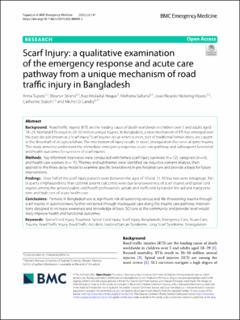| dc.contributor.author | Tupetz, Anna | |
| dc.contributor.author | Strand, Eleanor | |
| dc.contributor.author | Hoque, Kazi Imdadul | |
| dc.contributor.author | Sultana, Mohsina | |
| dc.contributor.author | Vissoci, Joao Ricardo Nickenig | |
| dc.contributor.author | Staton, Catherine | |
| dc.contributor.author | Landry, Michel | |
| dc.date.accessioned | 2023-03-14T10:29:38Z | |
| dc.date.available | 2023-03-14T10:29:38Z | |
| dc.date.created | 2022-10-19T13:33:22Z | |
| dc.date.issued | 2022 | |
| dc.identifier.citation | BMC Emergency Medicine. 2022, 22 (1), . | en_US |
| dc.identifier.issn | 1471-227X | |
| dc.identifier.uri | https://hdl.handle.net/11250/3058113 | |
| dc.description.abstract | Background
Road traffic injuries (RTI) are the leading cause of death worldwide in children over 5 and adults aged 18–29. Nonfatal RTIs result in 20–50 million annual injuries. In Bangladesh, a new mechanism of RTI has emerged over the past decade known as a ‘scarf injury.’ Scarf injuries occur when scarves, part of traditional female dress, are caught in the driveshaft of an autorickshaw. The mechanism of injury results in novel, strangulation-like cervical spine trauma. This study aimed to understand the immediate emergency response, acute care pathway, and subsequent functional and health outcomes for survivors of scarf injuries.
Methods
Key informant interviews were conducted with female scarf injury survivors (n = 12), caregivers (n = 6), and health care workers (n = 15). Themes and subthemes were identified via inductive content analysis, then applied to the three-delay model to examine specific breakdowns in pre-hospital care and provide a basis for future interventions.
Findings
Over half of the scarf injury patients were between the ages of 10 and 15. All but two were tetraplegic. Participants emphasized less than optimal patient outcomes were due to unawareness of scarf injuries and spinal cord injuries among the general public and health professionals; unsafe and inefficient bystander first aid and transportation; and high cost of acute health care.
Conclusions
Females in Bangladesh are at significant risk of sustaining serious and life-threatening trauma through scarf injuries in autorickshaws, further worsened through inadequate care along the trauma care pathway. Interventions designed to increase awareness and knowledge of basic SCI care at the community and provider level would likely improve health and functional outcomes. | en_US |
| dc.language.iso | eng | en_US |
| dc.publisher | BioMed Central | en_US |
| dc.rights | Navngivelse 4.0 Internasjonal | * |
| dc.rights.uri | http://creativecommons.org/licenses/by/4.0/deed.no | * |
| dc.title | Scarf Injury: a qualitative examination of the emergency response and acute care pathway from a unique mechanism of road traffic injury in Bangladesh | en_US |
| dc.type | Peer reviewed | en_US |
| dc.type | Journal article | en_US |
| dc.description.version | publishedVersion | en_US |
| dc.rights.holder | © The Author(s) 2022 | en_US |
| dc.source.pagenumber | 11 | en_US |
| dc.source.volume | 22 | en_US |
| dc.source.journal | BMC Emergency Medicine | en_US |
| dc.source.issue | 1 | en_US |
| dc.identifier.doi | 10.1186/s12873-022-00698-2 | |
| dc.identifier.cristin | 2062818 | |
| dc.source.articlenumber | 141 | en_US |
| cristin.ispublished | true | |
| cristin.fulltext | original | |
| cristin.qualitycode | 1 | |

